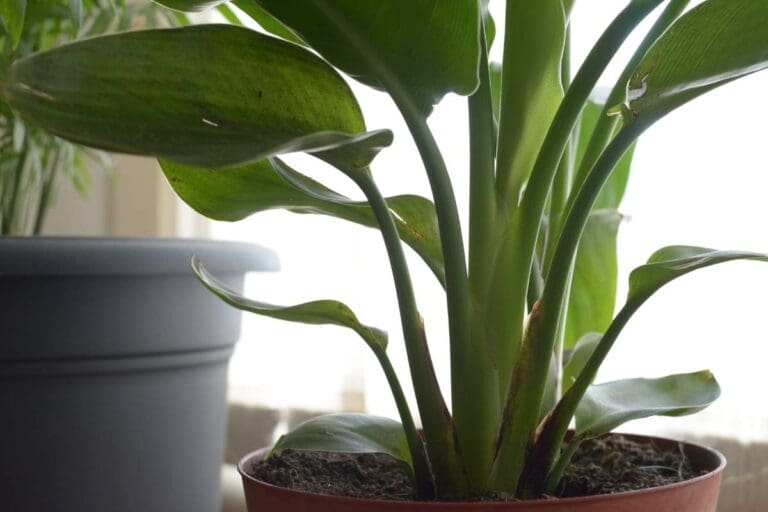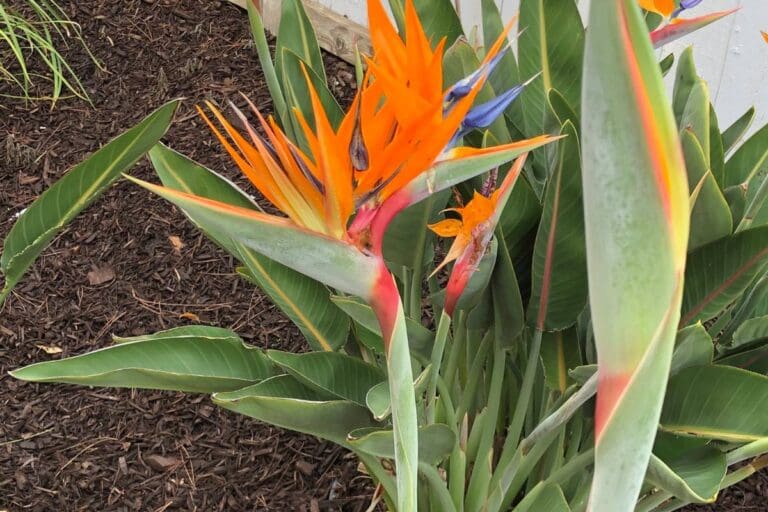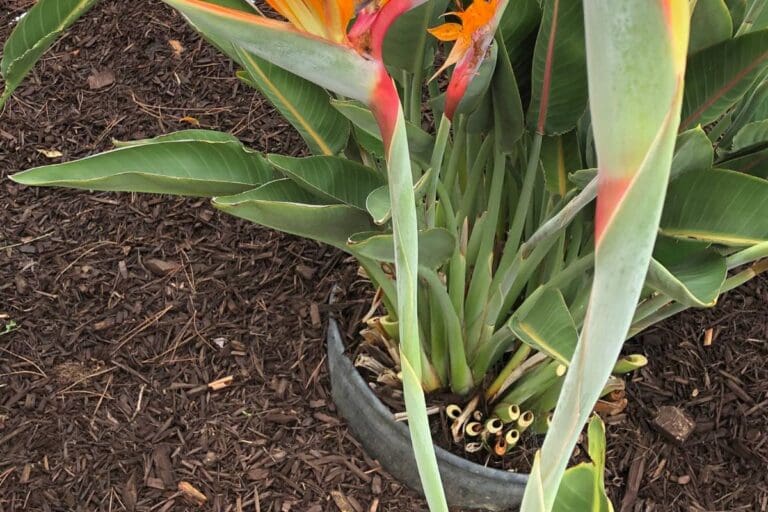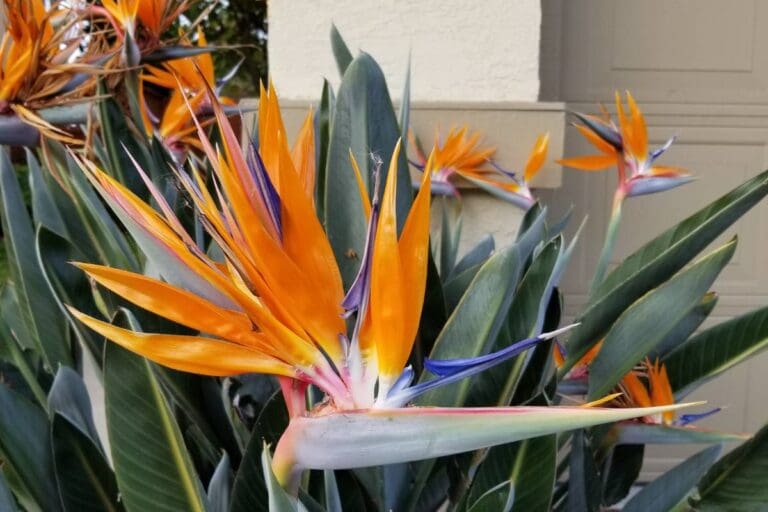Why Is Bird of Paradise Not Blooming? (8 Causes+Fix)
The bird of paradise (Strelitzia) is a popular ornamental plant known for their giant leaves and appealing blooms. The plant will bloom once it is fully mature and healthy. But you might be concerned if your bird of paradise is not blooming.
Bird of Paradise may not bloom due to several reasons, such as insufficient light, improper watering, lack of nutrients, pests, or disease. To fix this, increase light exposure, water adequately, fertilize regularly, and inspect for pests and diseases. Pruning and repotting may encourage blooming.
The plant will bloom if all the above conditions are checked and restored. Read this article to know how to fix the blooming issue in your bird of paradise plant.

Please note: Simplify Plants is reader-supported. Some links in the post are affiliate links and I get a commission from purchases made through links in the post.
Common reasons why a bird of paradise may not bloom
The bird of paradise produces colorful flowers resembling a bird in flight.
But it will only produce flowers under certain conditions and when it is fully mature.
If your bird of paradise plant is fully mature and still not flowering, don’t worry.
The plant might be perfectly healthy but may not get the right conditions for flowering.
I bought my bird of paradise 5 years back.
I provided it with proper care and expected blooms when it matured.
However, it didn’t!
I researched and found the cause for my plant not blooming.
I repotted my plant into a larger container last year, so it got stressed and wasn’t blooming.
I found that strelitzia likes to stay a little pot-bound for blooming.
I understood my mistake and didn’t repot it again.
I provided my plant with reasonable care and growing conditions, and soon my hard work paid off.
My plant got its first bloom last year which made me very happy.
There can be many other reasons why a bird of paradise plant may not flower.
Let’s check them out.
1. The bird of paradise plant isn’t getting sufficient light

A bird of paradise will only bloom if it has access to enough sunlight.
The bird of paradise loves sunlight, and they need much of it to produce blooms.
The plant needs at least 5 to 6 hours of brightness and heat from the sun to thrive and bloom.
Sunlight is required in the plant for carrying out various physiological processes to grow, bloom and produce seeds.
Exposing the plant to low light conditions will not provide them the energy for growing blooms even if they are fully mature.
2. The plant won’t bloom through the dormancy stage
Every houseplant has a growing season, followed by a period of rest known as the dormancy stage.
A growing season is when the plants receive all the ideal growth conditions similar to their natural habitat.
During this time of the year, the plant will achieve maximum growth and produce flowers.
However, the plant will stop flowering with low temperatures and decreased sunlight during winter.
The plant will go into a state of hibernation to survive winters, and it stores energy and nutrients for producing new growth and flower in the spring.
So, don’t get worried if your plant stops growing and flowering during winter as it is taking rest, and with consistent care, the plant will grow and bloom again when the growing season arrives.
3. Watering issues can affect blooming
Improper watering habit is one common reason that can prevent the plant from blooming.
Overwatering is more dangerous than underwatering, as it can even cause your plant to die.
Overwatering will limit the oxygen supply in the soil, which the roots need for breathing.
Too much water will cause plant root rot disease.
Signs of overwatering are yellow leaves, droopy leaves, brown leaves, lack of healthy flowers, etc.
On the other hand, underwatering will cause dehydration to the plant, weakening it and causing a lack of energy to produce blooms.
Therefore, following the correct watering procedure is essential for encouraging blooms in your bird of paradise plant.
4. The plant is exposed to unfavorable temperatures

The temperature is a vital factor when it comes to blooming.
Temperatures regulate the plant hormones and enzymes needed for blooming.
The ideal temperature range for the bird of paradise is 65 to 85°F during the daytime and 55-65°F at night.
There should be a 10-degree temperature difference between daytime and nighttime.
The outdoor bird of paradise will experience this temperature gap automatically.
However, indoor plants may experience the same temperature throughout the year, so they may not bloom.
If you can maintain this temperature range, you can cherish a long blooming period of your plant.
5. The plant isn’t getting ideal humidity
The bird of paradise is a tropical plant that prefers to grow in high humidity.
Keeping the plant in a low humid area causes dryness and underwatering issues.
The plant will need a minimum of 60 to 70% humidity for blooming.
If the air is too dry, the plant will excessively lose moisture through the leaves due to increased transpiration.
Hence, the plant will become weak and not be left with sufficient energy to produce blooms.
6. Nutritional deficiencies and other health issues that may prevent blooming
The bird of paradise is heavy feeders.
They need lots of nutrients to grow their large leaves and flowers.
If you aren’t feeding your plant enough or feeding it the wrong fertilizer, it will not bloom.
In the case of an indoor bird of paradise plant, the soil in the pot may not hold sufficient nutrients required for blooming.
This usually happens when the plant uses all the nutrients, and some wash away with watering.
If we don’t fertilize the plant at the correct time, its blooming will get compromised.
7. Frequent repotting of the plant will affect blooming

The bird of paradise plant likes to be slightly pot-bound for blooming.
The plant usually forms a large clump in the pot before it blooms.
Frequent repotting is one common mistake people often make with their bird of parade plant.
They think transferring the plant into a bigger pot with fresh potting will help it grow better.
However, this doesn’t apply to plants actively blooming or yet to bloom.
Repotting can cause transplant shock to the plant.
A plant suffering from stress will show signs of limpness, yellowing, stunted growth, and lack of blooms.
So, it is best to keep your plant in the same pot.
If you think the plant will get root bound, don’t worry; it will grow well and produce blooms only when the roots are crowded in the pot.
However, if you have repotted your plant, give it time to adjust to its new home.
Once the plant is adapted to its new environment, it will show signs of recovery and start producing flowers again.
8. Pest infested bird of paradise plant will not bloom
The pests will attack the bird of paradise plant when it doesn’t get ideal growth conditions.
Pests like aphids, mealybugs, spider mites, and scales are common to the bird of paradise plants.
The pests suck the sap from the plant, which contains essential nutrients and fluids for growth.
Without the sap, the plant will be deprived of nutrients and stop blooming.
The pests can kill your plant if you fail to catch them on time.
How to properly care for and maintain bird of paradise plants to encourage blooming?
Now that you know the causes that stop your bird of paradise plant from blooming, here are some tips that you can follow to fix the issues and make your plant bloom.
1. Move your bird of paradise plant to a sunnier location

Firstly, monitor how much sunlight your bird of paradise plant is receiving.
If it doesn’t get a minimum of 6 hours of bright indirect light, move it to the sunnier location of your house.
The best location for the bird of paradise plant would be an east or west-facing window.
These windows will provide the plant with the ideal light required for blooming.
You can keep the plant to a south-facing window during winters when light levels are low.
Rotate the plant regularly so that all the sides will receive an equal amount of sunlight.
You can also use artificial light if your house lacks natural sunlight.
2. Practice the best watering method for your plant
The best way to water your bird of paradise plant is to check the soil’s moisture level before adding water.
I always go right with watering since I have started following this method.
Insert your index finger 2 to 3 inches deep in the soil to check its dampness.
If the soil feels dry, water your plant immediately.
However, if the soil feels damp, avoid watering and wait a few hours until it dries.
Always water the plant thoroughly until the excess water starts draining out from the bottom of the container.
It will ensure that the water has reached all the portions of the root system.
Remember, the plant will dry out more quickly during the warm seasons, so you must water it regularly to keep it hydrated.
During winter, the plant will need less watering, so water the soil every 7 to 10 days, depending on the temperature.
3. Fertilize the plant adequately
To encourage blooms in your bird of paradise plant, fertilize it with a well-balanced liquid fertilizer with an NPK ratio of 10:10:10.
In the plant’s third growing cycle, use a fertilizer with a higher phosphorous content of about 30% to encourage flower growth.
Remember to check the application instruction on the fertilizers packet before feeding the plant.
Fertilize your plant every 2 weeks during the spring and summer and once every 6 to 8 weeks during winter.
Avoid using a fertilizer with higher nitrogen content as it will boost the leaf’s growth instead of blooms.
After feeding the plant, water the soil deeply so that fertilizers will evenly spread in the soil.
Never over-fertilize your plant, as the fertilizer salts can burn your plant’s root system.
I suggest you use a diluted fertilizer keeping strength to half portion to prevent over-fertilization.
4. Follow the best pruning techniques for encouraging blooms
To prune your bird of paradise plant, you will need a pair of gloves, disinfected pruners, and rubbing alcohol.
First, check your plant’s damaged, discolored, old leaves and parts.
Then, use the pruners to trim the base of the stem where the leaf is attached.
Make sharp and clean cuts.
Throw the trimmed leaves and stems and wash the pruners with rubbing alcohol.
Ensure not to prune more than 25% of the plant; otherwise, it will suffer from stress.
5. Try to maintain ideal temperatures and humidity for your plant

To encourage blooms in your bird of paradise plant, you must create conditions that mimic its natural environment.
To do this, try to maintain warm temperatures around the plant with enough humidity and air circulation.
Keep the plant away from hot and cold drafts.
Avoid keeping the plant near air conditioners, heating vents, gas burners, chimneys, etc.
During winters, keep the plant in a well-insulated room.
To encourage flower growth, maintain at least 60 to 70 % humidity around your bird of paradise plant.
There are some ways which can do to keep the humidity level steady:
- Mist the plant leaves regularly during the growing season with a spray bottle.
- Install a humidifier device to maintain the exact humidity range required by your plant. I use a warm mist humidifier for my Strelitzia.
- Group your bird of paradise plant with other moisture-loving plants to raise the humidity level in the air through transpiration.
- You can also place the plant in a humidity tray.
6. Take necessary measures for treating common pests and diseases affecting bird of paradise plants
If your bird of paradise has pests, you can follow the following ways:
- Handpick the visible after wearing gloves.
- Wash your plant with a powerful stream of water to remove as many pests as possible.
- Spray neem oil solution over the entire plant. Neem oil is the best natural insecticide for any houseplant. I apply it every month to my plants to keep away pests.
- You can use specific pesticides if your plant has a heavy infestation.
7. Keep patience
The bird of paradise plant will take many years for its roots to grow before it can start blooming.
If your plant’s root system remains undeveloped, it will never produce blooms.
Provide the plant with proper growth conditions and care until it is healthy and mature enough to bloom.
The blooms are a reward for your patience and efforts.
What is the role of plant maturity in bird of paradise blooming?

The bird of paradise will not produce flowers when they are fully mature.
The plant will take at least 3 to 4 years to mature.
If your bird of paradise plant is not blooming, check its age first.
If your plant is yet to mature, follow your regular care routine to keep it healthy.
But if your plant is fully mature and still not blooming, you must find the reasons that prevent it from blooming.
Remember, after buying any plant, write down the purchase date.
Ask the staff at the store to tell you the exact date when it was planted and its age.
If you have propagated your plant from seeds, then the plant will take 5-6 years to bloom.
So, keep patience and let your plant grow.
Final words
If your bird of paradise plant is mature and healthy and still not growing, inspect it thoroughly to understand what is stopping it from the flower.
In this article, I have discussed 8 reasons that can prevent the plant from flowering.
Once you figure out the issue, apply the solution discussed in this article.
Provide the plant with enough light, watering, fertilizer, temperature, and humidity.
Keep an eye on pests and spray neem oil once every month on your plant to keep the bugs away.
When does the bird of paradise plant bloom?
The bird of paradise plant starts growing flower buds in the winter season, and it takes 2 to 4 weeks for the flower to appear from the bud. The plant will continue to bloom till spring and sometimes till the beginning of the summer.
How long does the bird of paradise flower last?
The flower of the bird of paradise plant can last for 2 to 3 weeks before falling from the plant and dying. If you plug the fresh flowers from the plant, they will last another 2 weeks before they wither and die.
Reference: Wikipedia
Recommended Garden Supplies
| Product Image | Our Recommended Gardening Supplies | Check Offers! |
|---|---|---|
Top Top
Top
Top
Top
Top
Top
Top
Top | rePotme Houseplant and Tropical Classic Potting Soil Mix | Check Offer On Amazon |
 Top
Top
Top
Top
Top
Top
Top
Top | Espoma Organic Indoor Plant Food | Check Offer On Amazon |
 Top
Top
Top
Top
Top
Top
Top
Top | GooingTop LED Grow Light 6000K Full Spectrum Clip Plant Growing Lamp | Check Offer On Amazon |
 Top
Top
Top
Top
Top
Top
Top
Top | Soil Moisture Meter | Check Offer On Amazon |
 Top
Top
Top
Top
Top
Top
Top
Top | Govee Hygrometer Thermometer, Bluetooth Enabled! | Check Offer On Amazon |
 Top
Top | LEVOIT Humidifiers for Large Room(Best For Plants) | Check Offer On Amazon |
 Top
Top
Top
Top
Top
Top
Top
Top | Upgraded DIY Automatic Drip Irrigation Kit, 15 Potted Houseplants Support | Check Offer On Amazon |
 Top
Top
Top
Top
Top
Top
Top
Top | Stainless Steel Heavy Duty Gardening Tool Set | Check Offer On Amazon |
 Top
Top
Top
Top
Top
Top
Top
Top | Bonide Insecticidal Soap | Check Offer On Amazon |
 Top
Top
Top
Top
Top
Top
Top
Top | Bonide 32 oz Spray Neem Oil for Organic Gardening | Check Offer On Amazon |
 Top
Top
Top
Top
Top
Top
Top
Top | Garden Safe Fungicide | Check Offer On Amazon |






I was recommended this website by my cousin. I am not sure whether this post is written by him as nobody else know such detailed about my trouble. You are amazing! Thanks!
I do agree with all the ideas you have introduced on your post. They are very convincing and will definitely work. Still, the posts are very short for newbies. May just you please prolong them a little from subsequent time? Thank you for the post.
Thank you for your feedback and suggestion. We will work on the details for sure. In the meantime, if you have any questions or need further clarification on any topic, please feel free to ask and I’ll do my best to provide a more detailed response.
I am always searching online for articles that can aid me. Thanks!